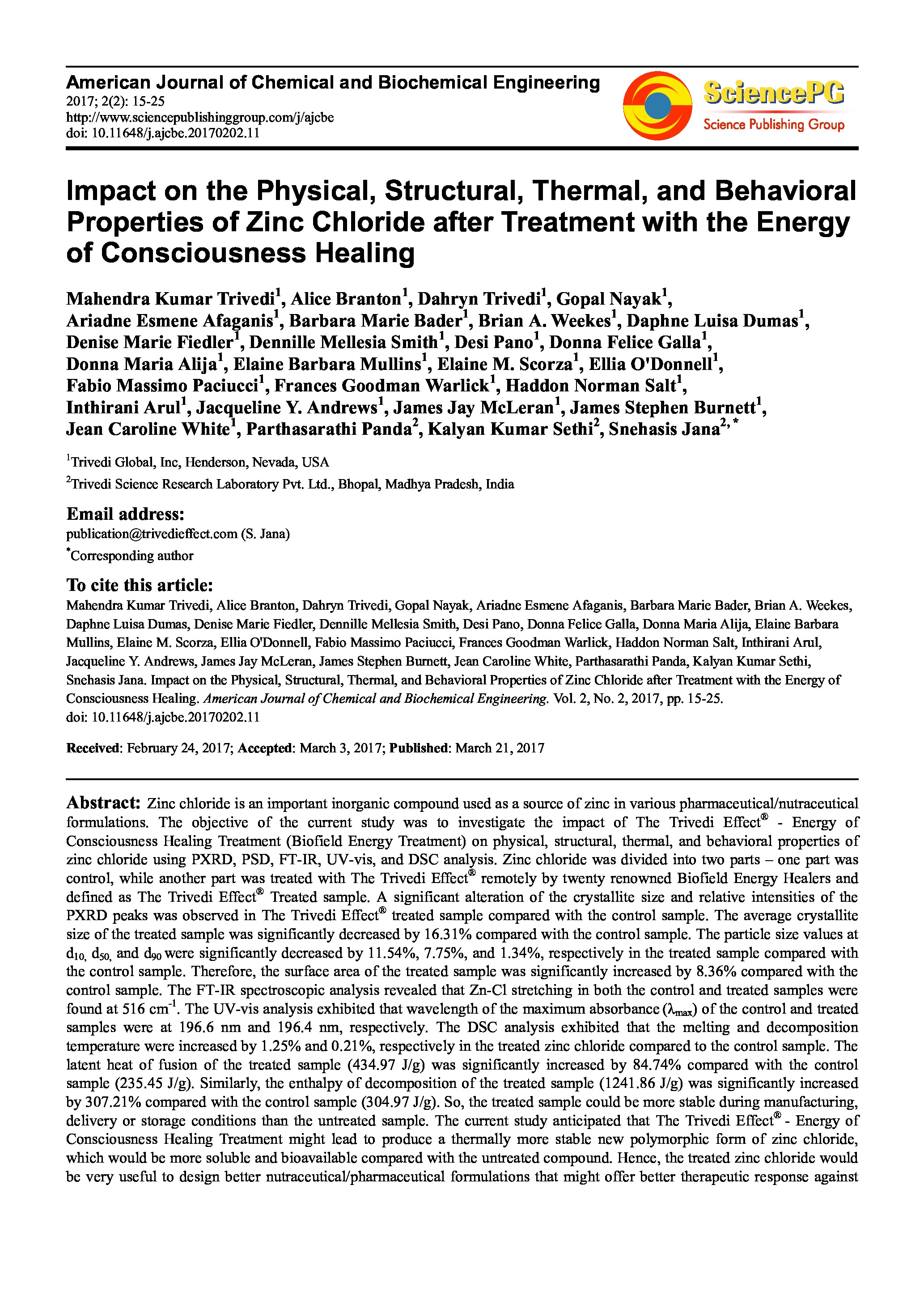Impact on the Physical, Structural, Thermal, and Behavioral Properties of Zinc Chloride after Treatment with the Energy of Consciousness Healing
Co-author
Mahendra Kumar Trivedi, Dahryn Trivedi, Gopal Nayak, Ariadne Esmene Afaganis, Barbara Marie Bader, Brian A. Weekes, Daphne Luisa Dumas, Denise Marie Fiedler, Dennille Mellesia Smith, Desi Pano, Donna Felice Galla, Donna Maria Alija, Elaine Barbara Mullins, Elaine M. Scorza, Ellia O'Donnell, Fabio Massimo Paciucci, Frances Goodman Warlick, Haddon Norman Salt, Inthirani Arul, Jacqueline Y. Andrews, James Jay McLeran, James Stephen Burnett, Jean Caroline White, Parthasarathi Panda, Kalyan Kumar Sethi, Snehasis Jana
Affiliation
Trivedi Global Inc.; Trivedi Science Research Laboratory Pvt. Ltd.
Main category
Natural Sciences (Analytical Chemistry, Method Development (Chemistr)
Abstract
Zinc chloride is an important inorganic compound used as a source of zinc in various pharmaceutical/nutraceutical formulations. The objective of the current study was to investigate the impact of The Trivedi Effect® - Energy of Consciousness Healing Treatment (Biofield Energy Treatment) on physical, structural, thermal, and behavioral properties of zinc chloride using PXRD, PSD, FT-IR, UV-vis, and DSC analysis. Zinc chloride was divided into two parts – one part was control, while another part was treated with The Trivedi Effect® remotely by twenty renowned Biofield Energy Healers and defined as The Trivedi Effect® Treated sample. A significant alteration of the crystallite size and relative intensities of the PXRD peaks was observed in The Trivedi Effect® treated sample compared with the control sample. The average crystallite size of the treated sample was significantly decreased by 16.31% compared with the control sample. The particle size values at d10, d50, and d90 were significantly decreased by 11.54%, 7.75%, and 1.34%, respectively in the treated sample compared with the control sample. Therefore, the surface area of the treated sample was significantly increased by 8.36% compared with the control sample. The FT-IR spectroscopic analysis revealed that Zn-Cl stretching in both the control and treated samples were found at 516 cm-1. The UV-vis analysis exhibited that wavelength of the maximum absorbance (λmax) of the control and treated samples were at 196.6 nm and 196.4 nm, respectively. The DSC analysis exhibited that the melting and decomposition temperature were increased by 1.25% and 0.21%, respectively in the treated zinc chloride compared to the control sample. The latent heat of fusion of the treated sample (434.97 J/g) was significantly increased by 84.74% compared with the control sample (235.45 J/g). Similarly, the enthalpy of decomposition of the treated sample (1241.86 J/g) was significantly increased by 307.21% compared with the control sample (304.97 J/g). So, the treated sample could be more stable during manufacturing, delivery or storage conditions than the untreated sample. The current study anticipated that The Trivedi Effect® - Energy of Consciousness Healing Treatment might lead to produce a thermally more stable new polymorphic form of zinc chloride, which would be more soluble and bioavailable compared with the untreated compound. Hence, the treated zinc chloride would be very useful to design better nutraceutical/pharmaceutical formulations that might offer better therapeutic response against inflammatory diseases, immunological disorders, aging, stress, cancer, etc.
Do you have problems viewing the pdf-file? Download paper
here
If the paper contains inappropriate content, please
report the paper. You will be redirected to the landing page.
